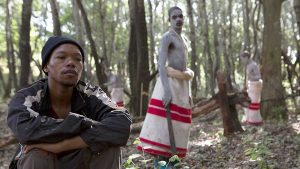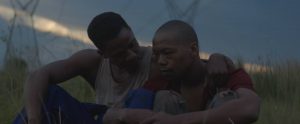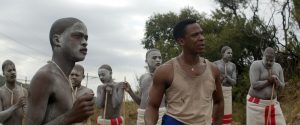Inxeba: The Wound, released in 2017, follows the process of initiation in the isiXhosa culture in South Africa. It is in some ways a coming of age story of Kwanda, a 16-year-old isiXhosa boy living in Johannesburg who must undergo the process. But the story centers around Xolani, an adult who completed the process many years prior and who now returns every year ostensibly to perform the role of the caregiver. The film highlights the toxic masculinities and economic disparity at play in this remote area in the Eastern Cape but is something of a microcosm for inequality and hegemonic masculinity across South Africa.
The film was met with controversy and protests for the portrayal of the sacred custom of initiation in the isiXhosa culture. However, because this had already been portrayed, albeit not so graphically, in the biopic on Nelson Mandela, The Long Walk to Freedom, there was wide speculation that the anger expressed was more of a result of the homosexuality in the film.
In this blog post, I will conduct a close viewing of Inxeba, which literally translated means The Wound, using some of the methods detailed in Martin Paul Eve’s book, “Close reading, computers and Cloud Atlas”. Although Eve used predominantly computational methods in his close reading, I will use his ideas to analyze the film through a multi-disciplinary lens and discuss its relevance in debates on decoloniality. I will not attempt to discuss the whole film, but rather have selected aspects relevant for this analysis. It should be noted that the chauvinism and toxic masculinity that emerge in this movie are prevalent in initiation processes in cultures and religions the world over, and are a reflection of a variety of historical, social, and political factors and not exclusively of the isiXhosa culture.

The audience is first introduced to the antagonist, Xolani at work in a factory, later referenced by another character as his job working for the white man. He moves from his workplace in the city to a visibly more rural area, riding in a wagon with other men and a goat to reach a clearing in a mountainous area. The setting, surrounded by a mixture of huts, wandering goats, and then a pristine car, creates a juxtaposition that exists throughout South Africa, the marriage between the traditional isiXhosa customs and the modernisation and urbanization of the country.
Xolani gets into the fancy car and is handed a wad of cash by the car’s owner. The owner of the car comes from Johannesburg. His son, Kwanda, is 16 and is about to participate in the tradition of initiation in the isiXhosa culture. He will be the initiate and will be circumcised by a surgeon. Xolani is being paid by the father to fulfill the role of Kwanda’s caregiver and oversee the circumcision and the two-week recovery process during which Kwanda will become a man.
The initiation process, colloquially known as “going to the mountain” or “going to the bush”, is saturated with traditional ideas of masculinity. In his first conversation with Xolani, Kwanda’s father expresses concerns about his son’s masculinity, referring to him as a “softie” and recounting stories of Kwanda taking boys to
his room and locking the door. This is the first reference to his sexuality in the movie, however as the movie progresses it becomes evident that although Kwanda has not disclosed it, the other initiates and some of the caregivers are aware that he does not like girls romantically.
Although not overtly defined, the men that these boys are to become in the process should embody hegemonic masculinity as defined by R. W. Connell and James W. Messerschmidt. The culture and conversations around manhood throughout the movie speak to constructs of heteronormative masculinity, including sleeping with girls or women, working and providing for their families, and being able to participate in stereotypically manly activities, like building fires or killing animals. Kwanda is described by various other characters as a softie, both because he is gay and because he comes from the city and is more wealthy. This is why Kwanda’s father has selected Xolani to be the caregiver, as he has a reputation for not being as harsh or careless as the other men.
Xolani accepts the responsibility to look after Kwanda and make him into a man. The process begins, and the audience bears witness to one of the first cinematic portrayals of the intimate and sacred isiXhosa procedure. A man who is referred to as the surgeon, although no other credentials are offered, individually visits each boy to begin the circumcision. The surgeon completes the process, and the novitiates must repeat, “I’m a man!” While all of the boys begin the process with some apprehension, Kwanda is even more reluctant. Although he is resigned to the fact that he must observe the custom, he resents it. Once the circumcision has been completed, the boys must remain in huts for the wounds to heal. It is in and around these huts that we learn that our antagonist, Xolani, has a romantic relationship with Vija, another caregiver. Vija has a wife and three daughters in the city but secretly identifies as gay.

The novitiates, their caregivers and the elders remain around their huts and tensions simmer. Vija’s relationship with Xolani vacillates between a lover and a bully. Privately, they engage in various sexual acts. When in public, Vija bullies Xolani as if to hide this vulnerability and assert his manliness to the boys, the other men, and Xolani in that space. Most of Vija’s dialogue in public spaces revolves around proliferating his manliness. When he initially hears about Xolani’s role as the caregiver of the “city boy”, he says, “They trust you with softies, I’d just make them cry.”
As the days in the huts pass, it seems to become a known fact that Kwanda is gay. The elders, caregivers, and boys constantly chastise him for being a city boy and for not liking girls. They use a variety of derogatory terms, including, “faggot”, and speak crassly about women. Kwanda is upset by it, but as he learns that Xolani is gay too, a different side of him is revealed. He questions why Xolani would live a lie, and presses him on what is so bad about being gay. Although in this setting, Kwanda is targeted with homophobic slurs and discriminated against, his attitude towards homosexuality here suggests that in his life in the city, being gay does not result in the same discrimination or vulnerability. This scene highlights Kwanda’s privilege compared to the other gay men, that he may return to his life in the city and be able to express himself with less fear of repercussions, while Xolani’s class and social environment prohibit him from doing so.
The conflation of identity constructs, being gay and being from an affluent area in the city, speaks again to the socio-economic climate of South Africa, but also brings into focus the way the film captures the complexities of race, culture, and class. The apartheid regime was only removed in South Africa in 1994, and according to Al Jazeera, the lack of reparations made means that to a large extent, economic disparity exists along racial lines, so poorer areas and townships consist predominantly of black people, while white people live in the wealthier areas. Affirmative action programmes have aided some people of colour in changing their financial situations, but they are the anomalies. Kwanda’s family is one of these anomalies, and the other initiates resent him for it out of jealousy. The elders also reveal their biases against people who they feel have abandoned isiXhosa people to live among white people. They believe Kwanda’s homosexuality is a consequence of being raised too softly and blame his father too. One elder says, “The father fucks off into the city as if he was banished from here.”
These kinds of nuances are really crucial to portray in cinema. Previously, Western and even local movies featuring black South Africans rarely highlighted the different classes and cultures so thoroughly, but rather created a single story that ignores the vibrancy and rich historical and political traditions of the numerous cultures in South Africa. It is also rare that in a film geared towards an international audience, isiXhosa is spoken for the duration of the film, only with English subtitles.

This represents progress towards the decolonisation of the film industry in South Africa, not necessarily because it is written and directed by South Africans in South Africa, but because the main characters are relevant and relatable to other South Africans, rather than being one-dimensional characters whose only role is to further the storyline of the central character.
Although many senior members of the production team were international, a platform was provided by South African people who had the agency to tell the story how they wanted to. This ties into Suren Pillay’s idea for what decolonisation looks like, in that it does not require that we get rid of Western film or ideas, but rather that we ensure there are ample opportunities and space for both.


Marly van den Boom
October 6, 2020 (13:48)
Really interesting piece Shannon! Definitely going to watch this movie 🙂
Shannon Lorimer
October 7, 2020 (07:35)
I’m glad you enjoyed it! Would definitely recommend the movie!
Mirjam de Bruijn
October 7, 2020 (19:21)
This is an interesting analysis of the film’ I am a man’, and you added to my understanding of the film that I watched last year. The kind of close reading that you did reveals how the film is indeed not a one-way story but encompasses multiple perspectives. It is in a way I think also a film about emancipation of men?